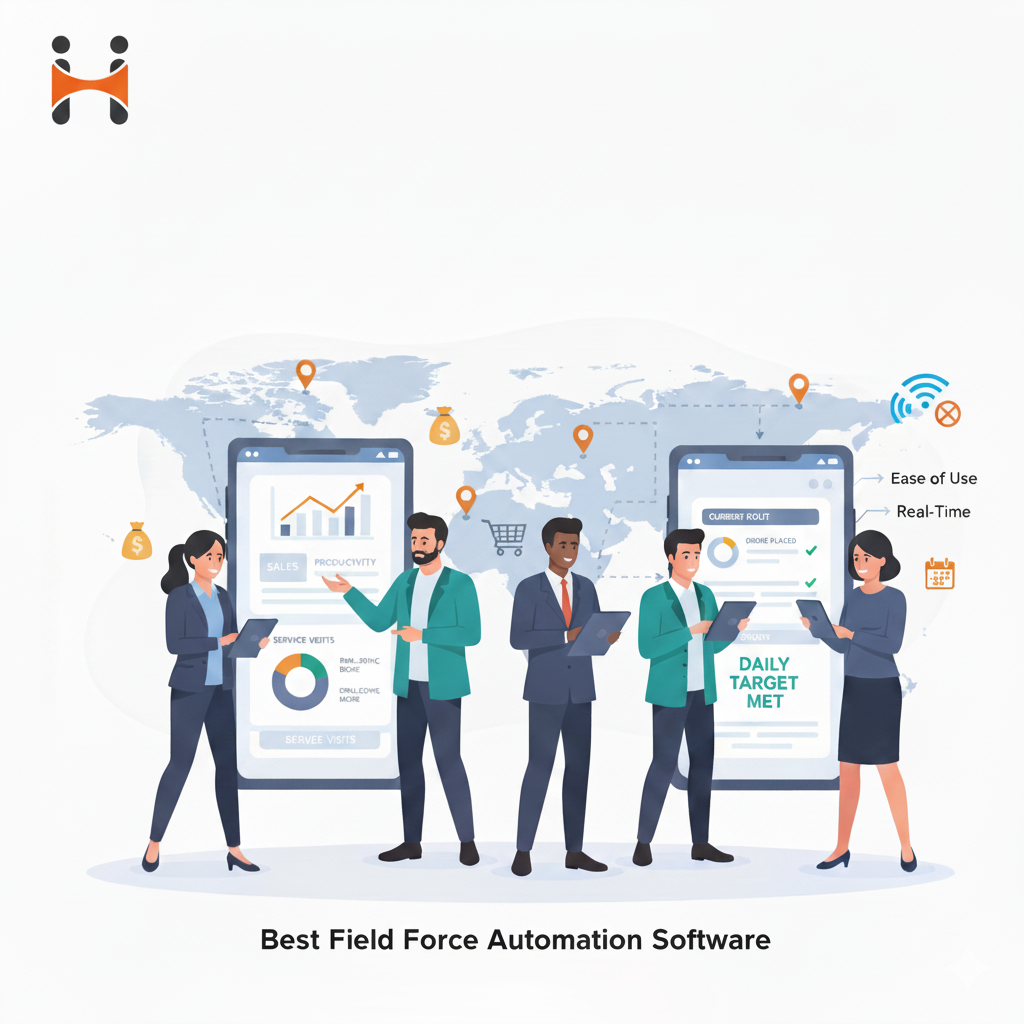Best Field Force Automation Software for Small Businesses in 2025

Introduction – why field force automation matters now?
Without field force automation software do your businesses with mobile teams face constant headaches. You deal with missed orders, messy routes, slow payments, and no clue what your team does. I’ve worked with FMCG and retail businesses, and Happisales system fixes these problems. It increases store visits, stops stockouts, speeds up cash flow, and tracks growth clearly. This post explains how to choose field force automation software, how it solves tracking and productivity issues, and how to evaluate vendors without wading through sales talk.
What is field force automation software?
Field force automation software streamlines mobile team operations. Struggling with manual processes? It fixes this with real-time data and clear insights. It helps managers make decisions based on facts. Here’s what it does:
- Manages sales, collections, orders, and service visits through mobile apps.
- Plans routes to save time and increase store visits.
- Works offline to keep field teams productive in low-network areas.
- Provides dashboards to track performance and growth.
- Replaces paper, Excel, or WhatsApp with instant data updates.
Challenges Small Businesses Face Without Automation
Small businesses with mobile teams face big challenges. Without field force automation software, you lose sales and waste time. From working with distributors and retail teams, I’ve seen these issues slow growth. Lack of transparency is the biggest hurdle. Fix that, and other problems get easier. Here are the key issues:
- Inventory shortages kill sales– Reps arrive at stores with no stock because inventory isn’t synced.
- Poor travel paths burn time– Bad planning raises fuel costs and cuts visits.
- Weak oversight hurts progress– Supervisors can’t confirm visits or coach staff well.
- Slow payments hurt cash flow– Paper receipts and delayed approvals create delays.
- Spotty networks stop work– Apps must work offline in smaller towns.
Key Features of the Best Field Force Automation Software
Picking the right field force automation software matters for small businesses. Don’t have the right mobile workforce tools? You’ll waste time and money. Focus on these features to ensure the software helps your team. They solve real problems and drive results. Here’s what to prioritize:
- Location tracking with geotagged visits – It confirms field visits, builds coverage maps, and prevents fake reports. Check for passive tracking versus manual check-ins, battery usage, and privacy settings like work-hours-only tracking.
- Offline-first mobile app- It lets reps log orders and data in areas with weak networks. Look for automatic data sync, conflict handling, and support for file or photo uploads.
- Route optimization with planned schedule- It boosts daily visits and cuts travel costs. Ensure it offers multi-stop routing, prioritizes key customers, and adjusts routes dynamically.
- Order and inventory sync in real time or near real time– It stops stockouts, prevents extra deliveries, and speeds reordering. Check for SKU-level updates, warehouse visibility, and low-stock alerts.
- Expense capture with fast approvals– It cuts reimbursement delays and boosts team morale. Look for receipt scanning, simple approval workflows, and payroll or ERP integration.
- Custom dashboards with performance analytics– They turn data into coaching insights, not just numbers. Ensure metrics cover visit conversion, average order size, route adherence, and collections aging.
- Privacy-focused tracking– It builds trust with mobile teams. Verify it tracks only during work hours, limits data retention, and restricts access to managers.
Real Benefits of Field Force Automation for Small Businesses
Our company has worked with small distributors and retail chains. Here’s what happens when automation is done right.
- More store visits– Smart routing and planning boost visits by 15-25% early on.
- Fewer stockout-. Real-time inventory and order syncing cut stockouts. Customers reorder more consistently.
- Quicker collections– Automated reminders and cash reconciliation speed up payment cycles and improve cash flow.
- Lower travel costs– Optimized routes save on fuel and overtime.
- Better coaching– Data-driven reviews make weekly sessions focused and useful.
- These results aren’t automatic, they come when teams stick to new processes and use the software regularly.
Buying Checklist: Questions to Ask Field Force Automation Vendors
Use this checklist when talking to vendors. It helps separate marketing claims from real features.
- Does the mobile app work offline and sync automatically when back online?
- How does geolocation work? Is it continuous tracking, check-in based, or both? How do you manage battery drain?
- Can routes be auto-planned and visits reassigned on the fly?
- Is inventory synced at the SKU level between field orders and the warehouse?
- What approval processes are there for expenses and returns?
- Can dashboards be tailored to track specific KPIs like visits, DSO, or order value?
- What integrations are available for ERP, payroll, or accounting systems?
- How is employee privacy protected, like time-limited tracking or data retention policies?
- What onboarding and training support is provided?
- Is there a free trial or pilot with real data and support?
Implementation Tips for Field Force Automation in Small Businesses
Small businesses succeed by starting with a quick pilot and scaling slowly.
- Test with a 2-4 week pilo- Select one area with 10-30 reps to try out processes.
- Chart current workflows– Keep what’s effective and digitize it first.
- Use short training– Go for 30-45 minute practical sessions, not long lectures.
- Pick three KPIs for the first 90 days– Measure daily rep visits, order conversion, and payment aging.
- Be clear about tracking– Share how it helps, what it does, and how privacy is protected.
- Adjust fast- Use pilot feedback to improve routes, alerts, and dashboards.
- Teams using this approach see better adoption and less resistance in the first month.
Quick Vendor Comparison Framework for Small Businesses
Pick the best vendors with this simple framework. Use it when you have 4-6 options.
- Core features (40%)– Check location tracking, offline app, route planning, inventory sync.
- Ease of use (20%)– Look for simple app design, good training, local language support.
- Integration and security (15%)– Confirm API options, encryption, compliance.
- Support and onboarding (15%)– Ensure rollout help, pilot support, local assistance.
- Cost (10%)– Demand clear pricing and ROI.
- Score each vendor 1-5 on these points to build a shortlist for pilots.
Field Story: How Automation Improved Productivity and Sales?
Our company helped a regional distributor whose field reps were unsure about tracking. We ran a two-week trial focusing on route planning and offline order entry. After a month, reps made 18% more visits on average. Stockouts dropped because warehouses got orders instantly. The team got excited about weekly leaderboards showing top performers, and more reps started using the system. The key was openness. The manager showed dashboards in weekly meetings, praised good work, and fixed minor issues. Putting people first worked better than tight control.
Choosing the Right Field Force Automation Software
To decide this week, follow these steps:
- Download two vendor apps. Test with a small team of 7-15 reps.
- Track three KPIs for 30 days. Measure daily visits, order conversion, collections DSO.
- Focus on adoption. Choose the tool reps find easiest.
- Protect privacy. Use time-window tracking before full rollout.
- Request a live demo. Use your customer list to test inventory and route features.
What’s next?
Small businesses can boost sales, cut costs, and manage their field teams efficiently with Happisales Field Force Automation Software. Start a 14-day free trial to track visits, orders, collections, and service tasks in real-time, even offline. Get a custom pilot and live demo tailored to your workflow, with actionable insights, notifications, and progress tracking to motivate your field executives.
Frequently Asked Questions
1. What is field force automation software?
Field force automation software is a tool designed for small businesses to manage mobile teams efficiently. It streamlines tasks like sales, order management, collections, and service visits. Key features include route optimization, offline mobile access, real-time inventory syncing, and performance dashboards to track team productivity.
2. What are the different types of field forces?
Types of Field Forces
- Sales Force – Sells products/services directly to customers; tracks leads, orders, and routes.
- Marketing/Brand Ambassadors – Promotes products, runs demos, collects customer feedback.
- Service/Support Force – Handles on-site installation, maintenance, and repairs.
- Collection/Finance Force – Manages cash collection, invoicing, and payment follow-ups.
- Distribution/Delivery Force – Delivers products, monitors stock, and optimizes routes.
3. What are the key features to look for in field force automation software?
When choosing software, focus on features like geotagged location tracking, offline mobile app functionality, route optimization, real-time order and inventory sync, expense capture, custom performance dashboards, and privacy-focused employee tracking.
4. How does field force automation software improve productivity and sales?
Field force automation improves productivity by optimizing routes, reducing stockouts, accelerating collections, lowering travel costs, and providing actionable insights for coaching your mobile teams. This leads to more store visits, better customer coverage, and higher sales efficiency.
5. How can small businesses choose the right field force automation software vendor?
Small businesses should evaluate vendors based on core features, ease of use, integration capabilities, support, and cost. Running a small pilot with key KPIs like daily visits, order conversion, and collection timelines helps ensure the software fits your team before a full rollout.

